Cell Lysis Market Size
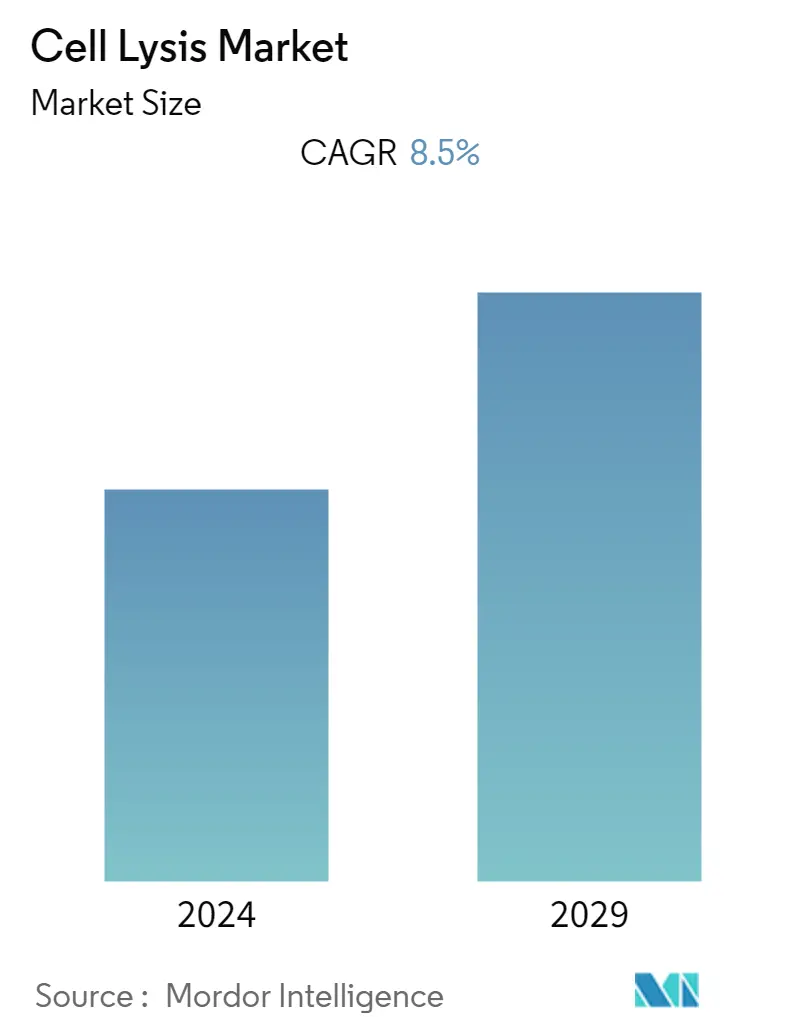
| Study Period | 2019 - 2029 |
| Base Year For Estimation | 2023 |
| CAGR | 8.50 % |
| Fastest Growing Market | Asia Pacific |
| Largest Market | North America |
| Market Concentration | Medium |
Major Players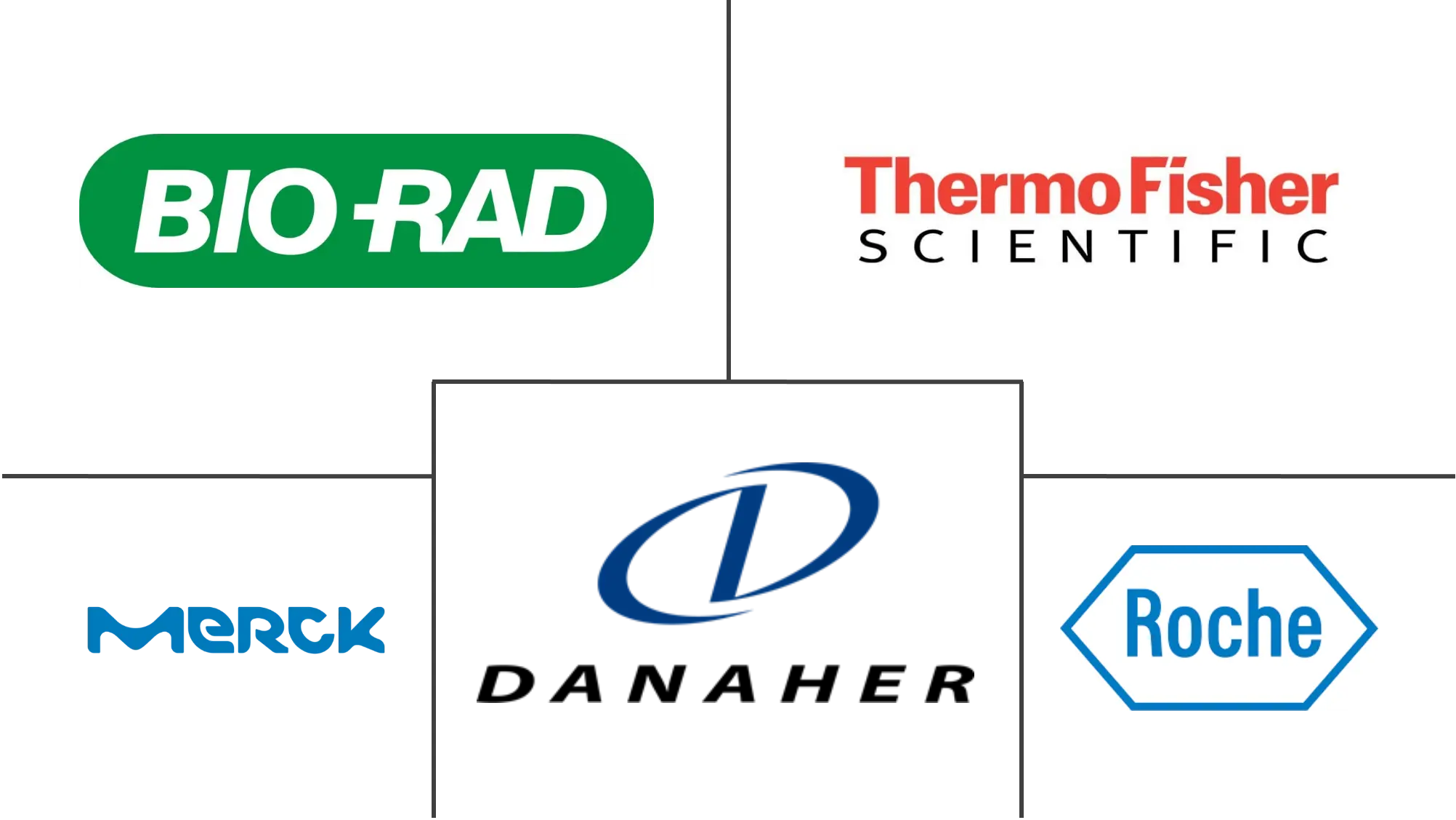
*Disclaimer: Major Players sorted in no particular order |
Cell Lysis Market Analysis
The cell lysis market is expected to register a CAGR of 8.5% over the forecast period.
Severe respiratory consequences of the COVID-19 pandemic prompted an urgent need for novel therapies that increased the number of drug discoveries, thereby positively impacting the cell lysis market. Several research studies were conducted to understand the effect of cell lysis on coronavirus. For instance, during the peak of the COVID-19 pandemic, the Department of Biotechnology (DBT) in India undertook a project to sequence 1,000 SARS-CoV-2 genomes from samples to understand the evolving behavior of the virus. The samples were collected across India to study the emerging mutations in the virus and how they change the symptoms of the disease. The increase in research activities that used different processes increased the demand for cell lysis devices and reagents.
The market is expected to grow due to increased expenditure on research and development, increasing application in the pharmaceutical and biopharmaceutical industries, and a rising focus on personalized medicine. Personalized medicine is one of the latest developments of gene-related studies that provide custom-tailored treatments as per the specific needs of patients, which has massive significance in disease prevention, diagnosis, prognosis, and therapeutics. According to the GLOBOCAN, in 2020, there were around 19,292,789 new cancer cases worldwide and about 9,958,133 deaths due to cancer. With the increase in the prevalence of infectious diseases and cancers, the use of cell samples for research and development of drugs also increases, which is expected to support the growth of the cell lysis market.
The high adoption of cell lysis and disruption methods during downstream processing to manufacture bio-therapeutics and other recombinant products further boosts the overall market growth. Furthermore, rising investments by governments and private organizations in R&D related to biotechnological processes and academics are expected to drive the market significantly. However, regulatory compliance and issues in the mechanical process in applying at the microscale level are some factors that might hinder market growth.
Cell Lysis Market Trends
This section covers the major market trends shaping the Cell Lysis Market according to our research experts:
Instruments are Expected to Witness Significant Growth in the Coming Years
Instruments are tools or devices used to lyse the cells. They are further categorized as sonicators, homogenizers, French press, microfluidizers, and others. Instruments like homogenizers and sonicators are used mostly for cell lysis/cell fractionation, and sonicators have the highest demand due to their increasing use in cell fractionation.
Recent advancements in cell lysis allowed the emergence of microfluidic devices in the cell lysis process. For instance, as per a study published by a Biotechnology Journal in April 2022, microfluidic technology is widely used for cell lysis. Separation and lysis of RBCs are helpful in the diagnosis of several diseases, which augments the demand for microfluidics in cell lysis, thus contributing to market growth.
With the rising number of chronic diseases and infectious diseases, there is a high demand in research laboratories and institutes and biopharmaceutical and biotechnology companies, which boosted the overall drug demand. For instance, as per the data from the American Cancer Society report published in 2022, around 1,918,030 new cancer cases were expected in the United States in 2022. This high number of cancer cases indicates the need for research and diagnosis of the disease, which is expected to propel the growth of the segment . The commercial availability and reliability of tools used in cell disruption and lysis also boost the growth of this segment.
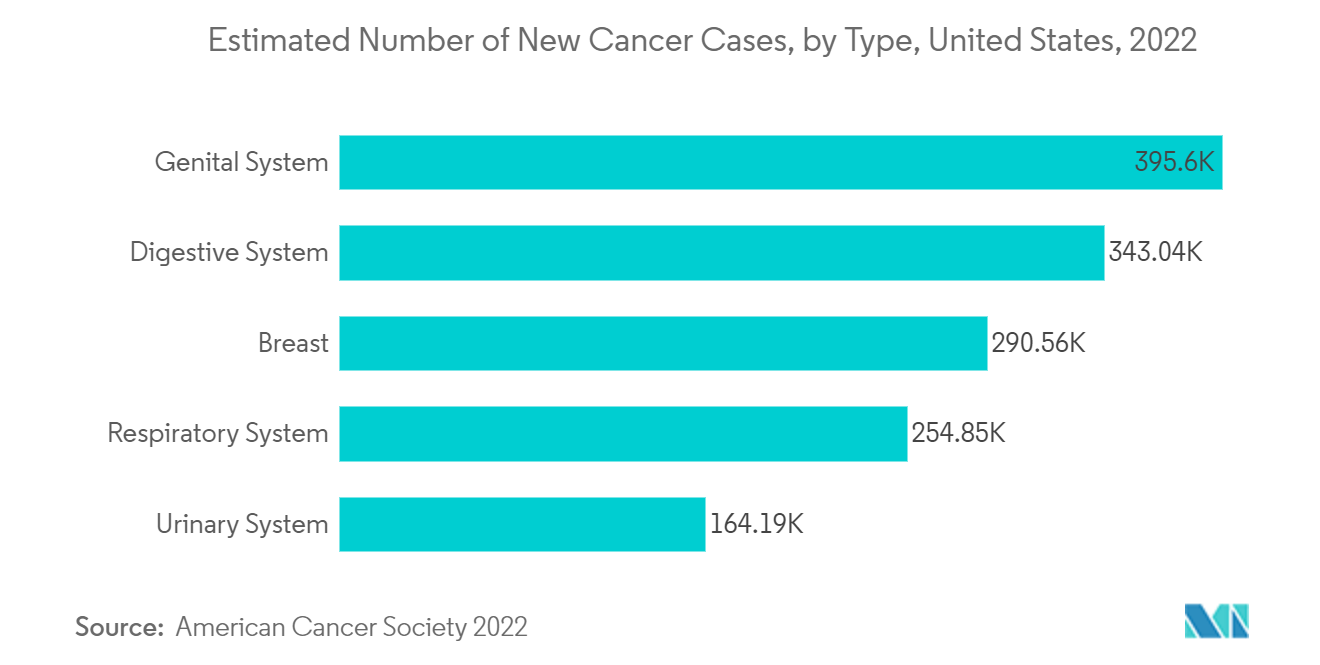
North America is Expected to Dominate the Market Over the Forecast Period
North America is spearheading the cell lysis market due to the increasing expenditure on research and development and increasing incidence of chronic diseases. With the rise in COVID-19, there was an increase in lab testing techniques, which was anticipated to intensify the progress of the cell lysis market. Furthermore, scientists researching COVID-19 cellular response and developing vaccines created a huge demand for cell lysis systems and reagents. Thus, increasing research in the region had a positive impact on the market.
The increasing demand for cell-based therapies for the treatment of cancer is also expected to augment the growth of the cell lysis market. The increasing prevalence and incidence of several diseases and rising research and development expenditure in North America trigger the need for an advanced research and development scenario across all life sciences sectors. According to the Pharmaceutical Research and Manufacturers Association (PhRMA), in 2021, US companies conducted over half the world's research and development in pharmaceuticals. The same source stated that approximately USD 102 billion was invested in biopharmaceutical R&D in the United States in 2021.
Hence, the continuous growth of healthcare infrastructure in the United States and the increase in the patient population provide wider opportunities for clinical laboratories to expand and help boost market growth.
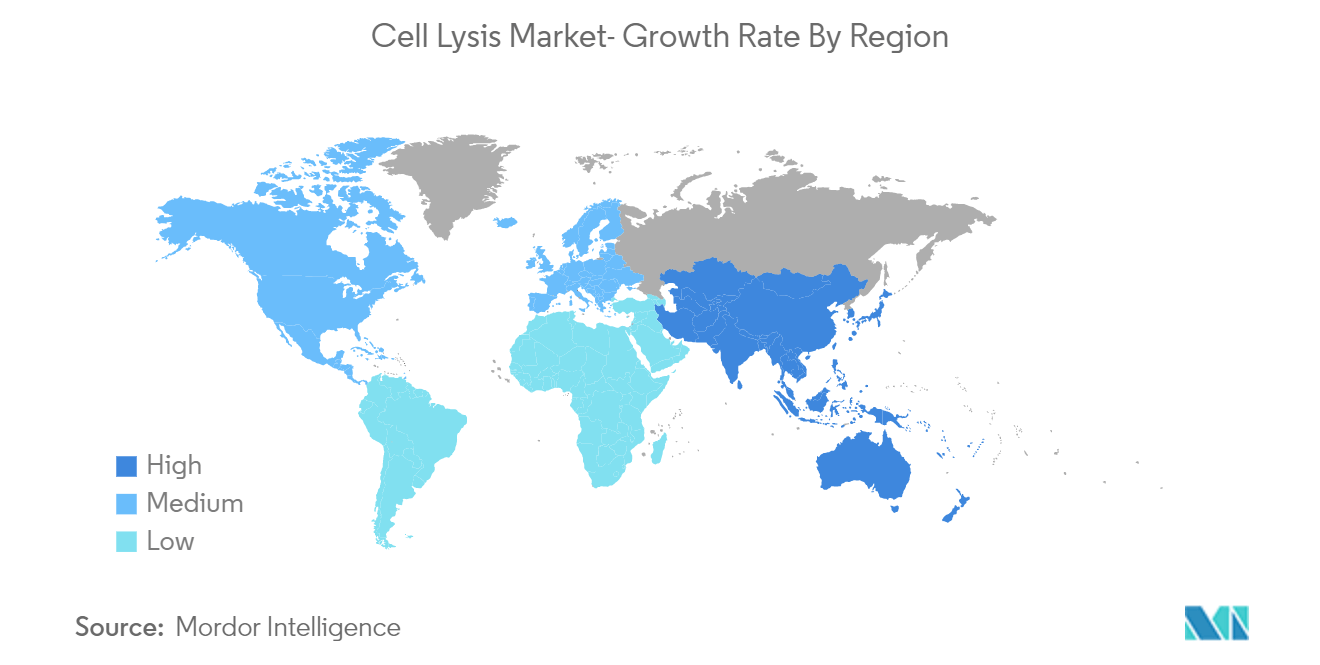
Cell Lysis Industry Overview
The market studied is moderately competitive and consists of local and international companies. Some players include Thermo Fisher Scientific Inc., Merck KGaA, F. Hoffmann-La Roche Ltd, Qiagen NV, Becton, and Dickinson and Company, among others. These companies focus on novel product developments and acquisitions/collaborations to enhance their market positions. With advancements in the pharmaceutical and biotechnology sector, few small to mid-sized companies have entered the market. It is believed that these companies will hold a substantial share of the market studied in the future. Competition is also increasing due to new product launches in this market.
Cell Lysis Market Leaders
-
Thermo Fisher Scientific
-
Bio-Rad Laboratories, Inc.
-
F. Hoffmann-La Roche Ltd.
-
Merck KGaA
-
Danaher Corporation
*Disclaimer: Major Players sorted in no particular order
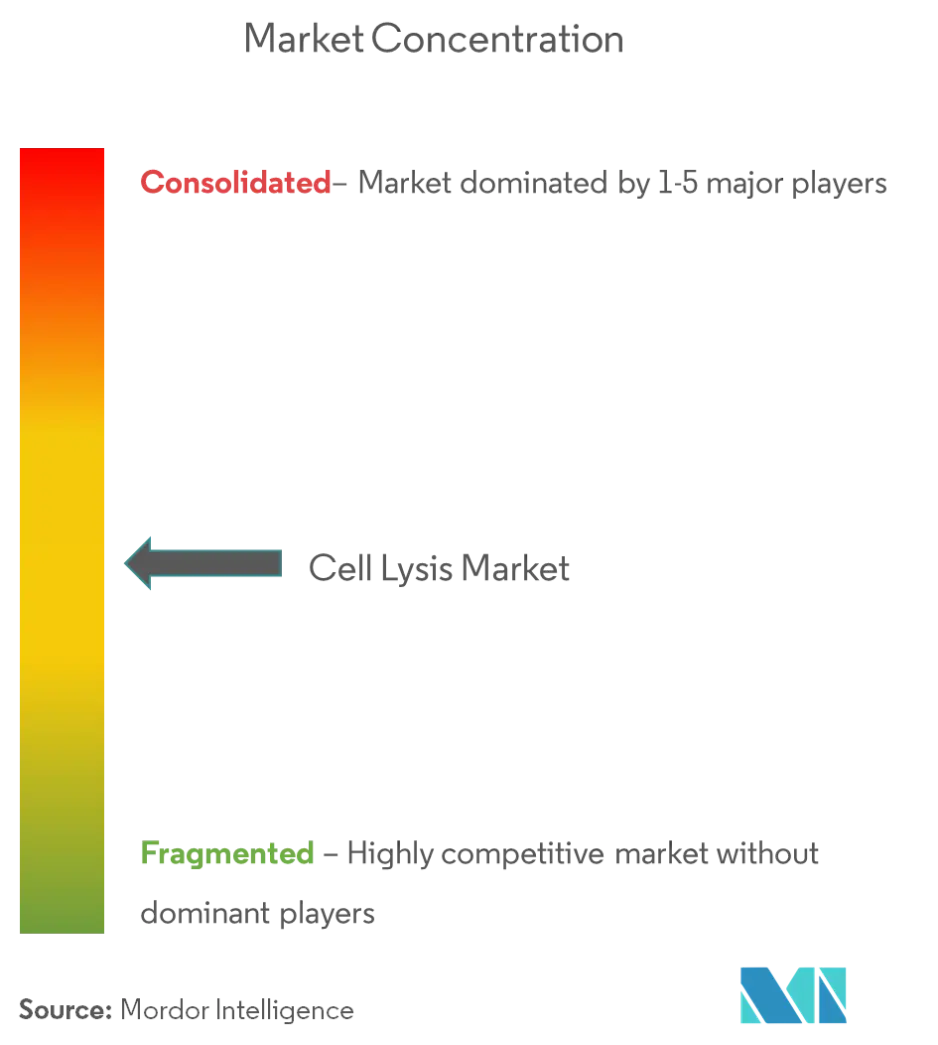
Cell Lysis Market News
- In September 2022, SCIENION and Cellenion launched the proteoCHIP LF 48 for label-free single-cell proteomics sample preparation on the cellenONE platform.
- In March 2022, Sanofi and IGM Biosciences, Inc. announced signing an exclusive worldwide collaboration agreement to create, develop, manufacture, and commercialize IgM antibody agonists against three oncology targets and three immunology/inflammation targets.
Cell Lysis Market Report - Table of Contents
1. INTRODUCTION
- 1.1 Study Assumptions and Market Definition
- 1.2 Scope of the Study
2. RESEARCH METHODOLOGY
3. EXECUTIVE SUMMARY
4. MARKET DYNAMICS
- 4.1 Market Overview
-
4.2 Market Drivers
- 4.2.1 Increasing Expenditure in Research and Development
- 4.2.2 Increasing Application in the Pharmaceutical and Biopharmaceutical Industries
- 4.2.3 Rising Focus on Personalized Medicine
-
4.3 Market Restraints
- 4.3.1 Regulatory Compliance
- 4.3.2 Issues in Mechanical Process to Apply at the Microscale Level
-
4.4 Porter's Five Forces Analysis
- 4.4.1 Threat of New Entrants
- 4.4.2 Bargaining Power of Buyers/Consumers
- 4.4.3 Bargaining Power of Suppliers
- 4.4.4 Threat of Substitute Products
- 4.4.5 Intensity of Competitive Rivalry
5. MARKET SEGMENTATION (Market Size - Value in USD million)
-
5.1 By Type of Product
- 5.1.1 Instruments
- 5.1.1.1 Homogeniser
- 5.1.1.2 Centrifugation
- 5.1.1.3 Other Types of Products
- 5.1.2 Reagents
-
5.2 By Type of Cells
- 5.2.1 Mammalian Cells
- 5.2.2 Microbial Cells
- 5.2.3 Plant Cells
-
5.3 By End User
- 5.3.1 Biotechnology or Biopharmaceutical Companies
- 5.3.2 Research Laboratories and Academic Institutes
- 5.3.3 Other End Users
-
5.4 Geography
- 5.4.1 North America
- 5.4.1.1 United States
- 5.4.1.2 Canada
- 5.4.1.3 Mexico
- 5.4.2 Europe
- 5.4.2.1 Germany
- 5.4.2.2 United Kingdom
- 5.4.2.3 France
- 5.4.2.4 Italy
- 5.4.2.5 Spain
- 5.4.2.6 Rest of Europe
- 5.4.3 Asia-Pacific
- 5.4.3.1 China
- 5.4.3.2 Japan
- 5.4.3.3 India
- 5.4.3.4 Australia
- 5.4.3.5 South Korea
- 5.4.3.6 Rest of Asia-Pacific
- 5.4.4 Middle East and Africa
- 5.4.4.1 GCC
- 5.4.4.2 South Africa
- 5.4.4.3 Rest of Middle East and Africa
- 5.4.5 South America
- 5.4.5.1 Brazil
- 5.4.5.2 Argentina
- 5.4.5.3 Rest of South America
6. COMPETITIVE LANDSCAPE
-
6.1 COMPANY PROFILES
- 6.1.1 Becton, Dickinson and Company
- 6.1.2 Bio-Rad Laboratories Inc.
- 6.1.3 Danaher Corporation
- 6.1.4 Eppendorf AG
- 6.1.5 F. Hoffmann-La Roche Ltd
- 6.1.6 Labfreez Instruments Group Co. Ltd
- 6.1.7 Merck KGaA
- 6.1.8 Qsonica LLC
- 6.1.9 Takara Bio Inc.
- 6.1.10 Thermo Fisher Scientific Inc.
- 6.1.11 Cell Signaling Technology Inc.
- 6.1.12 Miltenyi Biotec
- 6.1.13 QIAGEN NV
- 6.1.14 Claremont BioSolutions LLC
- 6.1.15 Microfluidics International Corporation
- *List Not Exhaustive
7. MARKET OPPORTUNITIES AND FUTURE TRENDS
** Subject To AvailablityCell Lysis Industry Segmentation
As per the scope of the report, cell lysis is one of the major steps in biological research to remove biological materials and use them in various downstream applications to fulfill research goals. Cell lysis is used in many industries, from pharmaceuticals to food, cosmetics, and biotechnology. The cell lysis market is segmented by product (instruments and reagents), type of cells (mammalian cells, microbial cells, and plant cells), end user (biotechnology or biopharmaceutical companies, research laboratories and academic institutes, and other end users), and geography (North America, Europe, Asia-Pacific, Middle East and Africa, and South America). The report also covers estimated market sizes and trends for 17 different countries across major regions. The report offers all values in USD million for the above segments.
| By Type of Product | Instruments | Homogeniser |
| Centrifugation | ||
| Other Types of Products | ||
| By Type of Product | Reagents | |
| By Type of Cells | Mammalian Cells | |
| Microbial Cells | ||
| Plant Cells | ||
| By End User | Biotechnology or Biopharmaceutical Companies | |
| Research Laboratories and Academic Institutes | ||
| Other End Users | ||
| Geography | North America | United States |
| Canada | ||
| Mexico | ||
| Geography | Europe | Germany |
| United Kingdom | ||
| France | ||
| Italy | ||
| Spain | ||
| Rest of Europe | ||
| Geography | Asia-Pacific | China |
| Japan | ||
| India | ||
| Australia | ||
| South Korea | ||
| Rest of Asia-Pacific | ||
| Geography | Middle East and Africa | GCC |
| South Africa | ||
| Rest of Middle East and Africa | ||
| Geography | South America | Brazil |
| Argentina | ||
| Rest of South America |
Cell Lysis Market Research FAQs
What is the current Cell Lysis Market size?
The Cell Lysis Market is projected to register a CAGR of 8.5% during the forecast period (2024-2029)
Who are the key players in Cell Lysis Market?
Thermo Fisher Scientific, Bio-Rad Laboratories, Inc., F. Hoffmann-La Roche Ltd., Merck KGaA and Danaher Corporation are the major companies operating in the Cell Lysis Market.
Which is the fastest growing region in Cell Lysis Market?
Asia Pacific is estimated to grow at the highest CAGR over the forecast period (2024-2029).
Which region has the biggest share in Cell Lysis Market?
In 2024, the North America accounts for the largest market share in Cell Lysis Market.
What years does this Cell Lysis Market cover?
The report covers the Cell Lysis Market historical market size for years: 2019, 2020, 2021, 2022 and 2023. The report also forecasts the Cell Lysis Market size for years: 2024, 2025, 2026, 2027, 2028 and 2029.
Cell Lysis Industry Report
Statistics for the 2024 Cell Lysis market share, size and revenue growth rate, created by Mordor Intelligence™ Industry Reports. Cell Lysis analysis includes a market forecast outlook to 2029 and historical overview. Get a sample of this industry analysis as a free report PDF download.



